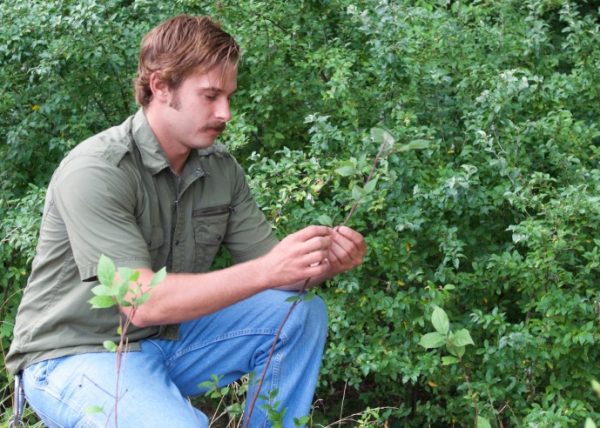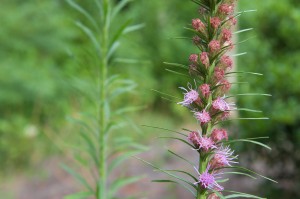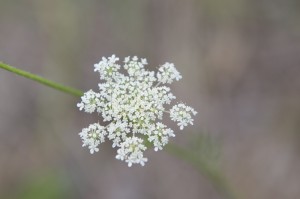Student Grows Campus Biodiversity With Re-Wilding Project

What began as a biological sciences’ extra-credit assignment bloomed into a project that is helping to slow the erosion of sediment into Toby Creek by converting a barren parking lot into a diverse natural habitat.
“We had been discussing in class how important increasing the type of plants on campus would be to increase overall biodiversity,” said Ian O’Shaughnessy, an undergraduate biology student who designed the project to re-wild Parking Lot 27. Re-wilding refers to returning an ecosystem to a previous state.
“I was walking on campus, and I noticed we had a lot of the same types of landscaping,” O’Shaughnessy said. “It was all manicured Bermuda grass and tall trees. I thought that increasing the number of plants and animals could help improve biodiversity.”
 Adam Reitzel, an assistant professor in biological sciences, had challenged O’Shaughnessy and the other students in his conservation biology class to consider the issue of biodiversity on UNC Charlotte’s campus.
Adam Reitzel, an assistant professor in biological sciences, had challenged O’Shaughnessy and the other students in his conservation biology class to consider the issue of biodiversity on UNC Charlotte’s campus.
“I have a personal passion for giving students the opportunity to engage in science,” Reitzel said. “Students have many opportunities to explore science in hands-on ways, and sometimes they are just not aware of that. I’m really interested in having my students engage outside the classroom and think about the relevance of what they’re learning in the classroom.”
The assignment called for students to present their conservation-based project plans to faculty members. O’Shaughnessy’s project moved quickly from theory to practice, as he presented his idea to university landscape architect Peter Franz, biological sciences faculty members including Carrie Wells and UNC Charlotte Facilities Management team members. The university team endorsed the project and suggested Lot 27 near Harris Alumni Center as an area that needed help.
“The whole parking lot was actually part of a sustainable design that intended for the sediment to go into a retention pond,” O’Shaughnessy said. “But it hadn’t worked out that way because the erosion happened too quickly. Maintenance had actually stopped maintaining the hill because it was futile. Every time it rained, all the mulch washed directly into the parking lot.”
The sediment and mulch then flowed into Toby Creek and the surrounding watershed.
 O’Shaughnessy researched hundreds of plants for their ability to hold the soil in place and attract insects and animals, consulting with Paula Gross of the UNC Charlotte Botanical Gardens and Scott Taylor, an expert on native plants.
O’Shaughnessy researched hundreds of plants for their ability to hold the soil in place and attract insects and animals, consulting with Paula Gross of the UNC Charlotte Botanical Gardens and Scott Taylor, an expert on native plants.
“We wanted to make sure that all the plants were native to the area,” O’Shaughnessy said. “So a lot of time was spent researching the ranges of different plants. We wanted to make sure that they served their role to help trap the sediment. I did some research into that issue, as well as increasing biodiversity and what would provide a food source for different things.”
O’Shaughnessy completed the planning phase within a few weeks, Reitzel said. “Then it came down to, ‘How are we going to get the money to do the project?” he said. “The idea’s here, we have a lot of interest.’ So that’s where Ian and I teamed up again in order to locate some funds.”
The Charlotte Green Initiative, a UNC Charlotte student group that focuses on sustainability efforts, provided funding. O’Shaughnessy recruited volunteers from the university and the community to install the excelsior matting and plants during the spring semester.
 In the months since, plants have flowered and attracted insects, birds and other animals. For the team that helped O’Shaughnessy bring his vision to life, the work is a testament to student creativity and initiative.
In the months since, plants have flowered and attracted insects, birds and other animals. For the team that helped O’Shaughnessy bring his vision to life, the work is a testament to student creativity and initiative.
“He had the insight and drive to initiate his project and the knowledge to implement it,” Franz said. “I was impressed with his dedication to environmental sustainability. Typically when students come to me about projects like this, I’m amazed at their commitment to it and knowledge they have about the subject. The benefit to the campus and community is to demonstrate the many components of sustainability. Since it is really a system-based concept, every demonstration project like Ian’s helps educate the community.”
For O’Shaughnessy, the project gave an opportunity to live his beliefs.
“I hope that people will see that a very simple idea when implemented can turn into something amazing,” he said. “There is really no insignificant effort. You don’t have to do something huge to make a difference. As a scientist, you have the obligation to do the morally right thing. You should use what you have learned for the good of everyone.”
Words: Skye Allan | Images: Lynn Roberson